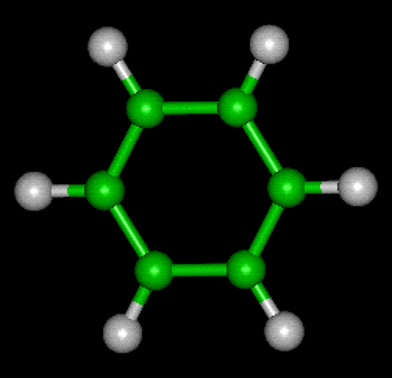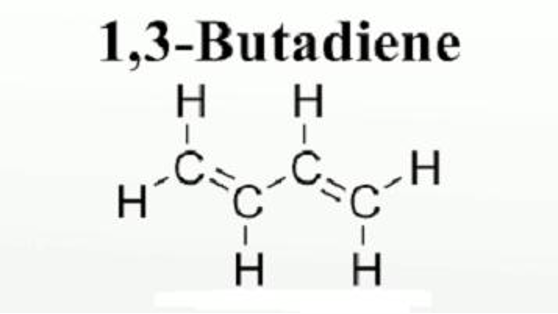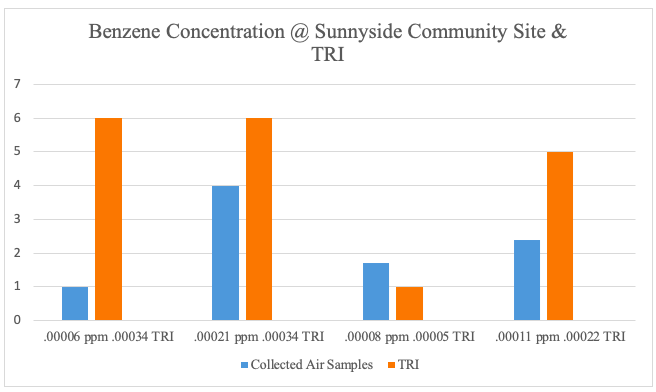 Benzene
Benzene

Benzene emitted from the Valero Houston Refinery and 1,3-Butadiene emitted from the Goodyear Company and Texas Petrochemical Corporation, in Houston, Texas, is dispersed in the air to the Park Place Neighborhood, the Texas Southern University Community, the Sunnyside Community, and other areas in the Greater Houston, Texas area. The fate of this dispersion is that it is inhaled by the residents. Exposure to benzene in the ambient air at or below the measured Toxic Release Inventory (TRI) for the Houston area, and exposure to 1,3-Butadiene in the ambient air at or below the measured (TRI) for the Houston area, produces a synergistic effect that increases the risk of developing blood ailments and cancers.
An exposure assessment is performed by: measuring the fill rate contents of the collecting canister, measuring the concentration of benzene and 1,3-butadiene in the air samples collected, and by observing the environmental conditions associated with the canister location. Fill rates (1hr fill rate, 2hr fill rate, 8hr fill rate, and 24hr fill rate) provide frequency data, timing of exposure, and levels of contact volatile organic compounds (VOCs). Dose-Response Assessment is that at or below 0.03 mg/m3 of benzene does not cause issues, above 0.03 mg/m3 cause adverse health effects; at or below 0.002 mg/m3 of 1,3-butadiene does not cause cancer, above 0.002 mg/m3 produces an increased risk of cancer development. Benzene and 1,3-Butadiene is detected in the air samples collected from the Park Place site, the Texas Southern University site, and the Sunnyside site. Chromatograms from Gas Chromatography/ Mass Spectrometry (GC/MS) analysis show the presence of benzene and 1,3-butadiene in the air samples.

Using the “Survey Questions,” the presence of cancer is observed from the screening of the residents of the neighborhood and communities.

This questioning verifies the increased risk of blood ailments and cancers from exposure to benzene and 1,3-butadiene in the air over Houston, Texas.
The at-risk individuals are the residents of the Park Place Neighborhood, the Texas Southern University Community, and the Sunnyside Community, of the Greater Houston, Texas area. These residents are at an increased risk of developing blood issues and cancers from inhaling the benzene and 1,3-butadiene in the air over the Houston, Texas area.
The preferred and easiest way to control the outcomes from exposure to benzene and 1,3-butadiene is to either remove benzene and 1,3-butadiene out of the petroleum and chemical industry, or to implement programs/ projects to help reduce the risk of exposure. Programs/ projects such as: using individual protective masks on days/ times when source emission levels increase or persist, projects that train in in-home air quality improvements, and programs that teach general information on benzene and 1,3-butadiene.
References
1.Benzene (C6H6) Structure, From “The Benzene Molecule,” by Worlds of Molecules, 2016, https://www.worldofmolecules.com/solvent/benzene.htm. Copyright [2016] by Worlds of Molecules. Reprinted with permission.
2. Molecular Structure of 1,3-Butadiene. From “Global 1,3-butadiene market 2016 – ExxonMobil, SABIC, Dow, Shell, Eni, ChevronPhillips Chemical, and Lyondell-Basell,” by openPR Worldwide Public Relations, 2018, https://www.openPR.com/news/390001/Global1-3-Butadiene-market-2016-exxonmobil-SABIC. Copyright [2018] by QY Research Group openPR. Reprinted with permission.
 Author: Gary Lee Murphy
Author: Gary Lee Murphy
Air Pollution Chair
Houston Sierra Club